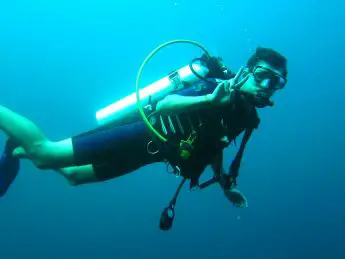Overview
Quick Navigation
In Scuba diving, it’s okay to float, at least if you would like to stay afloat. However, a scuba diver would need to go underwater many times, so he needs the weight to help counteract that the floating force to be able to sink slowly. If a Scuba diver has the weight spread correctly over his body, he can control the floating force, also known as trimming.
Decreasing and Increasing Weights in Scuba Diving
Sinking is achieved by increasing specific weight by having lead blocks distributed over a Scuba diver’s body. On the other hand, specific weight is reduced using air trapped in an airbag, also known as Buoyancy Control Device(BCD). The Lead’s shape is usually dependent on how the lead is annexed to the diver or equipment.
Lead is a poisonous metal that harms our environment. Therefore, lead usually comes in a plastic layer so that it can no longer come into contact with water or our skin. If lead granules are used, these granules are galvanized or provided with a nickel coating for the same reason.
Different Types of Diving Weights
Weight Belts
From the very beginning that people started diving, there were also weight belts. The most commonly used weight belt is made of nylon, to which the lead blocks are threaded. A weight belt can be a plastic or rubber belt to which lead blocks are threaded or a belt with pockets that hold soft lead pouches. The use of soft lead or lead blocks does not matter for functionality.
Weight belts are made of two kinds of material:
Polypropylene or Nylon Material: this is commonly used for its resistance and durability.
Rubber Material: this has a shorter lifespan compared to a nonmaterial. The advantage of the weight belts made with rubber Material, however, is the fastening of the lead and belt. However, it’s a bit more challenging to add the lead to the belt and also remove it from it.
The downside of a weight belt is that it puts some pressure on the hips.
Read about the Carolina rig here
Lead pockets
Many jackets and also wing BCDs are equipped with weight pockets. Here you can place lead blocks as well as soft lead. Soft lead is slightly better in that it will take the shape of the weight pocket better. Weight cubes tend to shift in these weight pockets during the dive.
There are several systems for shedding these weight pockets in an emergency. Due to the large difference in systems, it is recommended that during a buddy check, you always go over how you can quickly remove these pockets in an emergency and how they should be removed from your equipment. Just looking at a (red) colored buckle is not enough.
The advantage of these Lead pockets is that you do not have to remove all the lead pieces to adjust the weight. You only need to remove one weight from one of the bags and replace it with a heavier or lighter piece of lead. Besides, this belt also feels more comfortable because the weights are in the compartments
Lead harness
A weight harness is a weight belt that is fitted with shoulder straps. This weight belt does not rest on your hips and can therefore be attached in the most appropriate position for your trim. A lead harness is, therefore, really not only a matter for slightly heavier built divers. A lead harness can be filled very evenly with lead granules, which allows a very precise adjustment of the lead ballast. A lead harness is also provided with pockets so that the lead can be thrown off quickly.
Ankle lead
Ankle leads are lead blocks in a curved shape or ankle straps with an amount of soft lead. Lead cylinders (Bright-Weights) are also available for placement on the ankles. Usually, the weight of an ankle lead strap is 0.5 or max. 1 kg. Attaching ballast to the diver’s legs has advantages and disadvantages. (see above).
Backplate
The material from which the backplate of your wing-BCD is made certainly also plays a role in determining your amount of lead. Because this weight is very centrally placed on the body of the diver, many divers prefer to use a heavier backplate to have to carry fewer weight blocks. Be aware, however, that this ballast cannot be dropped in an emergency without also throwing off the entire dive unit.
Lead cubes attached to the dive tank
Some dive tanks are made of lighter materials such as aluminum or carbon fiber reinforced steel. These diving cylinders will therefore give less ballast (negative underwater weight) than their heavier versions made of steel. There are also differences in steel depending on the maximum operating pressure of these bottles, 200 – 230 -300 bar. The higher the operating pressure, the thicker the tank wall and the heavier the diving tank.
In warm tropical seas, diving is usually done with aluminum dive tanks. After all, you do not need or only need a very thin diving suit, and so you will have to take a very limited amount of lead as ballast. However, it becomes an entirely different story when diving in cold water where the use of thicker neoprene suits or dry suits is appropriate. You have to take more ballast (lead) with you anyway, and it doesn’t matter whether this ballast is taken in the form of extra lead or the form of heavier diving cylinders. When diving with lighter tanks, one will need to add lead bars on these tanks and amidst the tanks with a double set. They are V-shaped(V-weights) if the lead is placed in the middle of the tanks of a double set or P-shaped(P-weights) is placed behind the bottles with a double set. These lead blocks are not releasable.
The total loss of weight constituted by using carbon fiber reinforced bottles is offset mainly because you will have to take more lead. Nevertheless, considering that the carbon fiber reinforced diving cylinders possess almost 50% or more, the advantage remains substantially certain. (200/230 bar compared to 300 bar). Note that the lower the weight for transport to have these bottles filled, the less frequently these bottles are filled. The choice is that of every diver to make.
It is possible to have Lead attached to these bottles in pouches placed on the tank, with straps. It is important to place those bags, ensuring that the flap is at the bottom, i.e., if you click to open the buckle at the closing, the weight block or weight bag falls out by itself.
See the different types of fishing rods that exist
Conclusion
All you need to do is choose a scuba diving weight system that suits your BCD. If the BCD to have is one with weight pockets in it, it means you already have a weight system – you only need to be acquainted with the accurate amount of weight.
If your BCD is not integrated with weight pockets, you may select any of the various weight belts and adjust the strap with the required amount of weight to a perfect trim in your scuba diving. Also, read about finning techniques‘ here.

